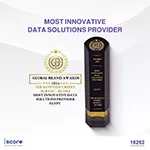Resources
Behind the Lines: The Surprising Story of Barcodes

- The barcode, invented in the late 1940s, revolutionised product identification and retail efficiency, first used commercially in supermarkets in the early 1970s.
- Despite its utility, barcodes have faced criticism and conspiracy theories, with some believing they symbolize dystopian control and are linked to the “Mark of the Beast” from the Book of Revelation.
- Today, billions of barcodes are scanned daily, playing a crucial role in various industries, including healthcare and logistics, while also facing emerging threats like QR code-related scams.
The barcode, a series of black and white lines that appear to be as common as the internet, has become an intrinsic part of modern life. From grocery stores to libraries, airlines to hospitals, barcodes have transformed how we identify, track, and manage products and information. However, few people explore the fascinating history behind this seemingly basic technology. Let’s look into the fascinating world of barcodes, which have played roles ranging from saving lives to sparking conspiracy theories.
The Birth of the Barcode
In 1969, Paul McEnroe and his IBM colleagues saw a future in which supermarket checkout lines would be altered by lasers scanning unique black-and-white marks on merchandise. This novel innovation was intended to speed up transactions, however barcodes were never employed commercially at the time. The concept originated in a patent submitted on October 20, 1949, by one of McEnroe’s colleagues. Despite the enthusiasm, IBM’s legal team initially opposed it, fearing “laser suicide” – the possibility that customers would accidentally harm their eyes and sue the corporation.
To allay these anxieties, McEnroe tested Rhesus monkeys to ensure that the low-powered lasers used in scanning were safe. His efforts paid off, as barcodes became commonplace in supermarkets across the United States, and later around the world.
From Concept to Reality
The Universal Product Code (UPC) that we use today is the result of McEnroe’s team’s collaborative efforts, including engineer Joe Woodland, who conceptualised the idea while doodling in the sand at the beach. Along with George Laurer and others, the team evolved the concept into a structured rectangle of black vertical lines, allowing for unique product identification across a wide range of products. The supermarket business officially adopted the UPC in 1973, with the first scan taking place at a Marsh Supermarket in Ohio in 1974.
The Mechanics of Scanning
When a laser beam flashes across a barcode, a complex process takes place within milliseconds. A UPC barcode is made up of alternating thick and thin black lines that correlate to a 12-digit number, similar to visual Morse Code. The first six to ten digits identify the company, then the item number, and finally a check digit for accuracy. This technique provides easy access to product information, such as pricing.
The advent of the UPC also paved the way for 2D barcodes, such as QR codes, which can contain more data and are becoming more common in digital transactions and marketing.
Controversies and Misconceptions
While barcodes have substantially enhanced retail efficiency, they have also been criticised and debated. Some people saw the technology as a danger to supermarket jobs, while others were concerned about pricing obfuscation, fearing they would lose bargain-hunting possibilities.
Furthermore, a subclass of conspiracy theories has evolved, linking barcodes to ominous predictions. In 1975, an essay proposed that barcodes could reflect the “Mark of the Beast” from the Book of Revelation, a theory that has gained traction over time. This belief was bolstered by claims that the number 666 was concealed within the barcode design. However, experts, like Laurer, have stated that these patterns are merely practical and not designed to communicate any malicious intentions.
Barcodes: Popular Culture and Modern Applications
Barcodes have invaded many parts of life, representing both convenience and dystopia. In films like The Terminator, barcodes imply dehumanisation, reflecting real injustices such as the tattooing of Holocaust victims.
Despite the controversy, barcodes have transformed areas beyond retail, such as healthcare, shipping, and manufacturing. They make it easier to track medical supplies, manage inventories, and promote e-commerce. With an estimated 10 billion barcodes scanned globally every day, their impact is significant.
Top 5 Companies that Provide Barcodes Worldwide
Zebra Technologies
Zebra Technologies is a global pioneer in barcode printing and scanning technology. Zebra is well-known for its creative technology and offers a diverse range of devices, including handheld barcode scanners, mobile laptops, and label printers. Their solutions are tailored to a variety of sectors, improving inventory management and supply chain efficiency.
Honeywell International Inc.
Honeywell is well-known for its automation and control solutions, which include powerful barcode scanners and mobile computing devices. Their barcode solutions benefit businesses in a variety of industries, including healthcare and retail, by streamlining operations, improving accuracy, and increasing productivity.
Datalogic S.p.A.
Datalogic focuses on autonomous data capture and industrial automation. They offer a wide variety of barcode readers, scanners, and imaging solutions. Their revolutionary technology focuses on increasing production and efficiency, making them a popular choice among global merchants.
SATO Holdings Corporation
SATO is a prominent provider of barcode printing solutions, with expertise in labelling, printing, and data capturing technologies. Their products serve a variety of industries, including manufacturing, logistics, and retail, by offering high-quality and long-lasting barcode labels that ensure dependability and accuracy.
GS1
GS1 is a non-profit organisation responsible for developing and maintaining global barcode standards, such as the Universal Product Code (UPC) and QR codes. They play a critical role in ensuring that barcode systems are efficient and compatible, allowing businesses to streamline processes and improve product tracking.
The Future of Barcodes
As technology advances, so does the possibility for barcodes. With the rise of digital transactions and contactless payment technologies, the use of barcodes and QR codes in everyday life will only increase. They are critical to keeping supply chains organised and providing seamless customer experiences in a continuously changing retail world.
Finally, the barcode’s evolution from an ambitious concept to a global standard exemplifies human intelligence and inventiveness. Despite its limitations and misconceptions, the barcode remains a cornerstone of modern commerce, always adjusting to meet the needs of an ever-changing world.




















































